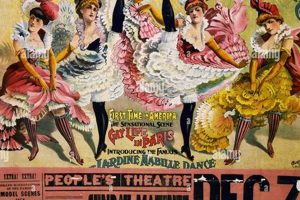Original promotional materials for films from earlier eras, typically pre-1980s, often printed using techniques no longer common, are highly sought after by collectors. These printed artifacts, designed to entice audiences to theaters, frequently showcase iconic imagery and typography reflecting the aesthetic sensibilities of their respective periods. For example, a vibrant lithograph promoting a 1950s science fiction film exemplifies this category.
These tangible pieces of film history offer significant cultural and artistic value. They provide a window into past societal values, advertising trends, and artistic styles. Furthermore, their limited availability and the enduring appeal of classic cinema contribute to their investment potential, transforming them into valuable commodities within the art and collectibles market. They serve as a historical record, visually documenting the evolution of the film industry and its relationship with its audience.
The following sections will delve into the various aspects that contribute to the value and collectibility of these items, including factors such as condition, rarity, and artistic merit. Specific artists and design trends significant to the field will be examined. Finally, best practices for preserving and displaying these fragile artifacts will be addressed.
Valuable Insights for Appreciating and Collecting Classic Vintage Movie Posters
The acquisition and preservation of original film advertising material requires careful consideration and knowledge. The following insights are intended to guide individuals in understanding the complexities of this specialized field.
Tip 1: Prioritize Condition: Condition directly impacts valuation. Look for specimens with minimal damage, such as tears, folds, or discoloration. Professional restoration can improve appearance but may affect long-term value if not properly executed.
Tip 2: Assess Rarity: Limited print runs and promotional usage contribute to rarity. Consider formats like insert posters or window cards, which were often produced in smaller quantities compared to one-sheets. Determine if the item represents an early release or a later reprint.
Tip 3: Verify Authenticity: Scrutinize printing details and paper stock. Compare the item to known authentic examples. Consult reputable dealers and collectors for expert opinions. Be wary of reproductions and bootlegs.
Tip 4: Research Studio Markings and NSS Numbers: National Screen Service (NSS) numbers and studio watermarks can help authenticate original items and provide context about their distribution. Familiarize yourself with the codes and their meanings for different eras.
Tip 5: Understand Artist Attribution: Recognizable artists, such as Saul Bass or Reynold Brown, can significantly increase value. Research artists known for their work in film advertising and identify their signature styles.
Tip 6: Storage is Crucial: Proper storage is paramount for preservation. Store flat in archival-quality sleeves and acid-free folders. Maintain a controlled environment with stable temperature and humidity to prevent degradation.
Tip 7: Consider Linen Backing: Linen backing provides structural support and helps flatten creases and folds. This preservation method can improve both the appearance and longevity of fragile artifacts. Choose a professional conservator with experience in this technique.
These insights highlight the importance of careful evaluation, authentication, and preservation when engaging with these tangible pieces of cinematic history. A well-informed approach ensures the long-term value and enjoyment of these cultural artifacts.
The subsequent sections will provide a deeper exploration into specific design trends and prominent artists. Additionally, advice on framing and display techniques will be offered to complete a comprehensive understanding.
1. Rarity
The scarcity of original film promotional materials significantly influences their value and collectibility. The limited nature of production, coupled with factors that contribute to attrition over time, establishes distinct levels of rarity among items from various eras and film titles.
- Limited Print Runs
Original printing quantities were often determined by the distribution of the film and the number of theaters exhibiting it. Consequently, items from smaller independent films or those with limited releases are inherently rarer than those from major studio productions with wide distribution. Example: A poster for a niche foreign film screened at a limited number of art-house cinemas would have a significantly smaller initial print run compared to a blockbuster title.
- Attrition and Loss
Paper-based promotional materials are susceptible to damage and degradation over time due to improper storage, environmental factors, and simple neglect. Many were discarded after their initial promotional use, further reducing their availability. Example: Posters displayed outdoors were exposed to sunlight, rain, and physical wear, leading to deterioration and eventual disposal.
- Format Specific Rarity
Different poster formats, such as inserts, window cards, and three-sheets, were often produced in varying quantities. Smaller formats or those intended for specific promotional purposes may have been printed in far fewer numbers, increasing their rarity compared to standard one-sheet posters. Example: A lobby card set, displayed within a theater’s entrance, typically has a smaller production run than the one-sheet distributed for widespread promotional use.
- Alternate Versions and Proofs
Variations in artwork, design, or printing errors can create unique and highly sought-after examples. Proof copies, intended for internal studio review, are exceedingly rare and can command premium prices among collectors. Example: A poster with a misprinted title or a significant design alteration, discovered before the main release, becomes a coveted item due to its unique status.
These factors, combined with the enduring popularity of certain films and the growing interest in collecting original film memorabilia, elevate the importance of assessing rarity when determining the value and desirability of promotional film artifacts. The confluence of limited supply and increasing demand drives the market for these increasingly scarce historical documents.
2. Condition
The physical state directly and significantly impacts the value and collectibility of original film advertising. Deterioration, in its various forms, diminishes both aesthetic appeal and historical integrity. Damage incurred through improper storage, handling, or environmental exposure reduces a poster’s market value. For example, a one-sheet from a highly regarded film suffering from significant paper loss, water damage, or extensive fading will be worth substantially less than a comparable specimen in near-mint condition. The degree of degradation is assessed through meticulous examination, considering aspects such as tears, creases, stains, fading, and paper brittleness.
Restoration, when performed by skilled professionals utilizing archival-quality materials, can improve the appearance and structural integrity of damaged items. Linen backing, a common technique, provides support to fragile paper and flattens creases. However, the extent and nature of restoration must be carefully considered, as excessive or poorly executed repairs can negatively impact value. Conservation reports detailing the original condition and the treatment performed are crucial for transparency and preserving the item’s historical record. The cost of professional restoration often factors into the overall acquisition budget, requiring a careful cost-benefit analysis.
Ultimately, the assessment of condition represents a crucial step in the valuation and responsible stewardship of these cultural artifacts. While some degree of age-related wear may be acceptable or even expected, significant damage invariably affects desirability and long-term preservation. Understanding the nuances of condition and its impact on market value empowers collectors to make informed decisions and ensure the enduring legacy of these tangible pieces of cinematic history.
3. Artwork
Original film advertising heavily relies on its visual components, serving as the primary mechanism for capturing audience attention and conveying a film’s essence. The artistic merit inherent in these pieces, spanning typography, illustration, and composition, directly influences their desirability and valuation in the collectors’ market. A captivating design, executed by a skilled artist, transcends mere promotion, elevating the artifact to a piece of independent artwork. The presence of recognizable artistic styles, such as the bold graphics of Saul Bass or the painted realism of Reynold Brown, substantially enhances an item’s collectibility. For instance, a poster featuring the distinctive artistry of Drew Struzan, known for his work on “Star Wars” and “Indiana Jones,” holds inherent artistic value alongside its historical significance.
Beyond individual artistic attribution, prevailing design trends of specific eras significantly shape the artistic character of these items. Art Deco influences, prevalent in the 1930s, manifest in geometric patterns and streamlined typography. The mid-century modern aesthetic, popular in the 1950s and 1960s, showcases bold colors and abstract imagery. Recognizing these stylistic cues enables collectors to appreciate the historical context and artistic evolution reflected in these artifacts. The use of vibrant lithography in early examples provides a different artistic appeal compared to the photo-based designs that became more common in later decades.
In essence, the artistic quality functions as a pivotal determinant in evaluating classic movie advertising. Its presence is not merely decorative; it is intrinsically intertwined with the item’s historical, cultural, and monetary worth. Identifying the artistic style, acknowledging the artist (when known), and recognizing the design trends of the period enables a deeper appreciation and informed assessment of these tangible pieces of cinematic history. Neglecting this element leads to an incomplete valuation and an underestimation of their importance as cultural artifacts.
4. Provenance
Provenance, the documented history of ownership for an object, plays a vital role in establishing the authenticity and value of original film advertising. A clear and verifiable chain of ownership provides confidence in the item’s legitimacy and can significantly enhance its desirability among collectors. The absence of provenance raises red flags and casts doubt on an item’s origins, potentially diminishing its worth or rendering it unsellable.
- Original Owner Documentation
Direct evidence of ownership, such as letters from studio employees, receipts from original sales, or annotations from theater owners, provides compelling evidence of an item’s origins. For example, a poster accompanied by a letter from a former National Screen Service employee detailing its distribution to a specific theater lends considerable credibility to its provenance. This type of documentation eliminates ambiguity and establishes a direct link to the item’s legitimate past.
- Auction Records and Dealer History
Records from established auction houses and reputable vintage poster dealers can serve as valuable components of provenance. Previous auction catalogs or dealer invoices provide a public record of ownership and valuation, lending further support to an item’s authenticity. For instance, a poster previously sold at a recognized auction house like Christie’s or Sotheby’s possesses a documented history that increases its appeal to collectors.
- Exhibition History and Published References
Evidence that an item has been featured in museum exhibitions or published in books or articles on film history adds to its provenance and enhances its perceived value. Inclusion in recognized scholarly works or museum collections implies that the item has undergone scrutiny and has been deemed authentic by experts in the field. A poster referenced in a definitive book on film advertising, for example, gains credibility and historical significance.
- Family History and Inherited Items
Although more difficult to verify, a documented family history connecting an item to a relative who worked in the film industry or owned a theater can contribute to its provenance. Affidavits or notarized statements from family members can provide supporting evidence, though independent verification remains crucial. For example, a poster inherited from a grandfather who operated a movie theater, supported by family photos and records, strengthens its claim to authenticity.
In summary, establishing comprehensive provenance for original film advertising is paramount. Each piece of historical evidence, from original owner documentation to auction records, contributes to a stronger claim of authenticity and increased value. Prudent collectors prioritize items with clear and verifiable histories, safeguarding their investment and preserving the integrity of these cultural artifacts. The diligence invested in researching provenance ultimately yields greater confidence in the item’s legitimacy and long-term appreciation.
5. Historical Significance
Original film advertising materials serve as tangible artifacts of cultural and historical import, reflecting the societal values, artistic trends, and marketing strategies of their respective eras. The historical significance of these promotional items directly correlates to the impact and reception of the films they advertised. A poster for a film that profoundly influenced cinematic techniques, addressed pivotal social issues, or achieved widespread critical acclaim carries greater historical weight. For example, advertising from landmark films such as “Citizen Kane” or “The Birth of a Nation” provides insights into evolving artistic expressions and shifting societal attitudes of their time. Understanding the film’s place in history provides crucial context for appreciating the poster as more than just a decorative object. Its value is derived, in part, from the films contributions and impact on cinematic art, culture, or society.
The preservation of these historical documents ensures future generations can study and understand the evolution of film as an art form and its relationship with society. These posters, often designed to capture the zeitgeist, provide a visual representation of the cultural climate surrounding a films release. Advertising for films made during periods of war, social upheaval, or technological innovation offers unique perspectives on these historical events. Moreover, the study of these items reveals shifts in marketing techniques and advertising strategies, providing insights into the evolving relationship between the film industry and its audience. Consider, for instance, materials from early silent films, which represent an early stage of commercial cinema, and serve as a direct link to this historical period.
Recognizing and understanding the historical significance fundamentally enriches the experience of collecting and appreciating these unique artifacts. These materials are not simply commodities but are representative of pivotal moments in cinematic and cultural history. They offer valuable insights into the past, providing tangible connections to the films, the artists, and the audiences who shaped them. By acknowledging their historical context, these items are elevated from mere collectibles to valuable cultural assets, offering unique perspectives on the evolution of both cinema and society. Ignoring the historical component risks undervaluing the artifact and overlooking its crucial role in documenting our cultural past.
Frequently Asked Questions
This section addresses common inquiries and misconceptions surrounding the acquisition, preservation, and valuation of promotional materials for classic films.
Question 1: How is the authenticity of original film advertising verified?
Authentication requires careful examination of printing techniques, paper stock, and studio markings. Comparison with known authentic examples and consultation with reputable dealers are recommended. National Screen Service (NSS) numbers, if present, should align with the film’s release period.
Question 2: What factors significantly impact the value of these items?
Condition, rarity, artwork, provenance, and historical significance are paramount. Exceptional condition, limited availability, notable artistry, a well-documented ownership history, and the film’s cultural impact all contribute to increased valuation.
Question 3: What are the best practices for storing and preserving vintage advertising?
Archival-quality sleeves and acid-free folders are essential. Flat storage in a controlled environment with stable temperature and humidity minimizes degradation. Linen backing by a qualified conservator provides structural support.
Question 4: Is professional restoration recommended for damaged items?
Professional restoration, when performed by experienced conservators, can improve appearance and structural integrity. However, the extent of restoration must be carefully considered, as excessive or poorly executed repairs may negatively impact value. A detailed conservation report is crucial.
Question 5: What are some common types to collect and how do they differ in value?
Original one-sheet styles, insert posters, lobby cards, and window cards are frequently collected. One-sheet posters, due to their large size and visibility, often command higher prices. Inserts and window cards, produced in smaller quantities, can also be valuable. Lobby cards are valued as collections of scenes.
Question 6: Should one invest in linen backing?
Linen backing is recommended for items in fragile condition or those exhibiting creases and folds. The process provides a stable foundation, preserving the paper. This is a professional service that requires evaluation by a qualified conservator.
A thorough understanding of these considerations is essential for informed decision-making in the realm of cinematic advertising. These pieces of advice serve to help navigate the complexities of this specialized sector.
The following section provides specific resources for further exploration and expert guidance.
Classic Vintage Movie Posters
This exploration has illuminated the multifaceted nature of promotional artifacts for classic films. The assessment of rarity, condition, artistic merit, provenance, and historical significance establishes a framework for understanding valuation and appreciating these items. These printed materials represent a significant intersection of art, commerce, and film history, demanding careful consideration and responsible stewardship.
Continued research and informed collecting practices are essential for preserving the cultural legacy of original film advertising. The sustained interest in these tangible pieces of cinematic history ensures their enduring relevance as valuable artifacts and unique windows into the past. Engaging with knowledgeable experts and adhering to established preservation guidelines will ensure these assets continue to enrich our appreciation of cinematic heritage for generations to come.







